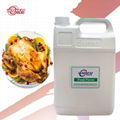| Model: | A16 |
|---|---|
| Brand: | Baisfu |
| Origin: | Made In China |
| Category: | Agriculture & Foods / Processed Food / Health Food |
| Label: | increase food flavor , High purity |
| Price: |
US $94
/ kg
|
| Min. Order: | 1 kg |
| Last Online:31 Jan, 2024 |
Zingerone CAS number: 122-48-5
Alias: vanilla-based acetone
Molecular formula: C11H14O3
Molecular weight: 194.23
Melting point: 40℃
Relative density (25/25℃) : 1.136~1.140
Refractive index (20/20℃) : 1.538~1.545
Content: ≥95.0%
EINECS number: 204-548-3
FEMA code: 3124
Color: light yellow or amber crystal
Smell: Strong ginger like pungent smell sweet, spicy rich and deep floral aroma
Solubility: Soluble in ethyl ether and dilute alkali, slightly soluble in water and petroleum ether, soluble in 50% ethanol at a ratio of 1:1.
Halal (MUI) Authentication Status: Not authenticated
Halal (SHC) Authentication Status: Not authenticated
kosher Certification Status: Certified
Implementation standard: GB 29938-2020
Shelf life: 36 months in unopened condition
Storage conditions: This product is stored in a cool and ventilated place to avoid all kinds of miscellaneous air pollution.
Source: extracted from ginger essential oil; Or condensed from vanillin and acetone; The plant is derived from the rhizome of Zingber officinale Rosc., the seed of Amomun melegueta Roscoe, which can also be obtained by hydrogenation of vanillin and acetone with catalyst, and can be regarded as the homolog of capsaicin. It has anesthetic, cooling and antiemetic effects, and can be used as a spice and a caustic stomachic. Ginger and gingerone can inhibit prostaglandin synthesis, especially pge2 and leukotriene synthesis, which can explain its analgesic, antipyretic and anti-inflammatory effects to a certain extent.
Uses and precautions: perfuming spices; China's "health standard for the use of food additives" (GB2760-1996) stipulates that it can be used to prepare various food flavors according to the production needs. According to FEMA, the maximum reference dosage is 6.9mg/kg for soft drinks; Ice cream, ice food, 7.8mg/kg; Candy, 11mg/kg; Baked goods, 11mg/kg; Chewing gum, 15mg/kg.
The main synthesis methods of ginger oil ketone are:
1. Vanillal was used as starting material to prepare dehydrogingerone (b) by Claisen-SehMIDT condensation reaction of d4 with acetone at room temperature under alkaline conditions, and then by Pd/C catalytic hydrogenation to produce gingerone;
2. Vanillin was used as the starting material for silanization and condensation reaction with 2-methylsiloxy-1 propylene, and then dehydrogenated by hydrolysis. Gingerone was then reduced by Raney-Ni at -10°C with a catalytic reduction yield of 75% and a reduction by-product of 61%.
3. Vanillin was used as the starting material to prepare dehydrozingerone with 94% yield by Cloisen-SehMIDT condensation reaction with acetone for 42 h under alkaline conditions, and then reduced with special active Raney-Ni.
Product use:
1, for food, milk and bread aroma (increase flavor) to improve the taste, so that the aroma lasting;
2, used for shampoo, facial mask, cream, shower gel, perfume soap, daily chemical, lasting fragrance;
3, used in electronic cigarettes, tobacco, aroma, increase the taste, improve the aroma;
4, professional perfumers can use the formula to improve the aroma and make an attractive aroma.











